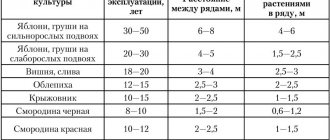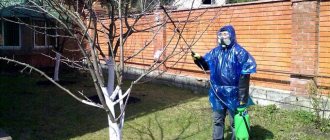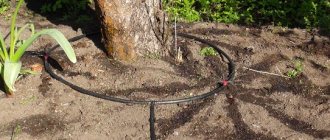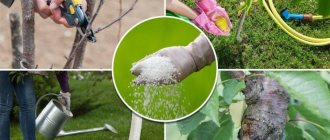Spring is the time to plant fruit trees; this is the “hottest” season for summer residents. The most common garden crops in the middle zone are apple trees, pears, cherries and plums. As in any business, it is necessary to follow the rules of planting fruit trees - only in this case, after a certain period, they will be able to please you with a bountiful harvest and will bear fruit regularly. The organization of any garden begins with trees. Spring planting of fruit trees and shrubs is the best option, although this can be done in summer and autumn.
Spring tree planting: pros and cons
Let's start with the benefits of planting trees in the spring:
- In the spring, it is possible to observe the process of plant survival, and the likelihood that it will freeze, as often happens in winter, is practically reduced to zero.
- You will have enough time to prepare everything related to planting fruit trees: fertilize the soil, think over a planting plan, acquire tools, which means the procedure itself will be more efficient.
We recommend reading these articles:
Planting garlic in spring in open ground, timing
of planting nigella onions according to the lunar calendar 2021
How to germinate potatoes for planting at home
The disadvantages of spring planting are as follows:
- Seedlings should be purchased in the fall, since in the spring the choice on the market will not be as wide.
- If the summer is hot, young trees will have to be watered almost every day.
How to choose the right fruit tree seedling for planting in spring?
For planting in spring, preference should be given to seedlings over 1 year old. Such specimens take root well and are rarely damaged by diseases. When purchasing a seedling, it is important to pay attention to the following criteria:
- there should be no signs of disease on the tree, the bark should be smooth without damage;
- the roots of the seedling should be light in color without compaction or rot;
- the seedling must have healthy buds, from which young shoots will come in the future.
In order to reduce the risk of purchasing low-quality goods, it is important to contact specialized organizations selling planting material. Before selling, such organizations treat seedlings against possible pests.
Planting an apple tree in spring
Apple tree seedlings require a hole 80 cm deep and up to a meter in diameter. In this case, it is better to make the side walls with an angle of 60°. The apple tree prefers soils with normal acidity. Lime can help balance acidic soils, but it is added in the fall so that in the spring the soil does not have purely limestone lumps that can harm the root system of the tree.
The distance between apple trees when planting should be from 4 m, and if a row garden is planted, then the row spacing will be 6-7 m. The depth of the hole for cherries is usually from half a meter, and its diameter is 0.8 m. The row spacing is approximately 3 m, as well as space between trees in the same row.
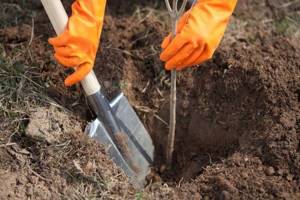
Planting in autumn
When planted, annual and biennial seedlings must be of high quality, standard size 70-80 cm, with a well-developed, uncut root system. The leaves must be completely torn off before planting. The cut roots are not able to conduct moisture into the trunk and leaves, and the leaves continue to suck moisture from the seedling. Therefore, plants planted with an open root system with foliage die from dehydration by spring. Autumn is a favorable time for planting shrubs with an open root system.
When dug up in the autumn, cotoneaster, hawthorn, caragana, barberry, and fruit bushes take root no worse than seedlings purchased with a closed root system and are several times cheaper. When choosing a site for planting any trees and shrubs, you should pay attention to the topography of the site. Places in the lowlands are not suitable, since they are the coldest, which will lead to freezing of seedlings in winter, or during the flowering period in spring if there are frosts.
Autumn planting takes longer than spring planting. Planting seedlings in the fall begins approximately from September 15 to October 20. Before a steady cold snap, trees and shrubs have time to take root. Later planting, due to drying out of the roots, often leads to their freezing.
Planting cherries in spring
You can plant cherries in open ground in the spring immediately after the night and day air temperatures are above 0 °C. In most regions, such weather sets in already in April. Planting cherries in spring has many advantages, but it has one significant drawback. In spring, the plant will spend energy not only on growing and strengthening its underground part, but also on increasing green mass, as well as the formation of shoots. Therefore, at this time he will need more nutrients, and his care should be more thorough.
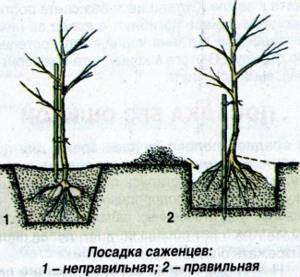
Planting pears in spring
It is best to plant pears in the southern, western or southwestern parts of the garden, since the root system of this fruit plant constantly needs moisture, and the crown does not like excessive heat.
Pear seedlings are planted in the fall in holes that need to be dug in the spring. However, if the site is located in a climate zone where frosts in winter reach 30 degrees, then young plantings may die. That is why planting a pear in the spring is considered a more reliable solution, because by winter the tree has time to grow and become sufficiently strong, and the roots go deeper into the ground.
A hole for seedlings must be made up to 0.5 m deep and up to 1 m wide, carefully loosening its bottom. The soil that is raked out of the hole should be mixed with peat and then placed back into it.
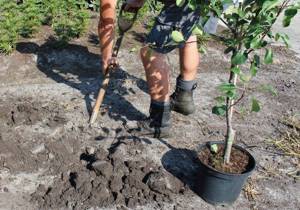
Choosing a place to plant plants
The planting site must be selected according to the type of root system and the depth of groundwater. Plants with a superficial and fibrous root system can be planted if the groundwater is close, but plants with a core system in such areas are not planted.
Many years of practice of planting various trees and shrubs in problem areas with high groundwater levels has shown that the only acceptable way to improve the situation is to plant seedlings on raised elevations - hills, ramparts. The height of the elevations is adjusted taking into account the height of the maximum standing groundwater, differently for each specific fruit tree or shrub. Stone fruit crops cannot tolerate close groundwater and die.
Before planting plants near structures and buildings, you need to familiarize yourself with certain rules. Closely planted trees with a shallow root system can lead to the foundation being lifted by the roots, while fibrous and tap roots can affect communications laid in the ground. To avoid this, there are well-known standards given below.
Planting plums in spring
- Spring planting is carried out in the third decade of March - early April.
- Of all fruit crops, it tolerates high soil moisture best of all.
- Plum develops well and produces a bountiful harvest on soils with sufficient calcium content; on acidic soils, the plant often gets sick and dies.
- Therefore, when planting seedlings, add 500 g of wood ash, fluff lime, dolomite flour or chalk to each hole.
- To increase productivity, plant at least three different varieties of plums in the garden with different ripening periods, since plums bear fruit better in the presence of pollinator varieties.
- Dig a planting hole 60-80 cm deep and 80 cm wide. Pour vegetable humus or rotted manure into the hole (up to 3-5 buckets). For mineral fertilizers, add 150 g of phosphorus fertilizer, 60 g of potash and a bucket of river sand. Mix everything thoroughly with the soil that was removed from the hole and pour it into the hole. Then dilute dolomite flour, wood ash or fluff lime in 10 liters of water and pour into the hole. Pour two buckets of water into the hole and leave it for a week.
- On the day of planting the seedling, the hole can be watered with a growth stimulator. Before planting, drive a stake into the hole, leaving 50 cm above the surface, pour the soil nutrient mixture into the hole so that a mound is formed.
- Take a seedling, place it on a mound, spread the roots evenly and cover it with plain soil without fertilizer, while the root collar should be at soil level or 2-3 cm above the soil surface.
- Shake the seedling several times so that there are no voids left between the roots, then compact the soil well, but very carefully, water and mulch. As mulch, use a 5 cm layer of dry humus. A layer of mulch will protect the soil from moisture evaporation.
- The distance between plum seedlings should be 2 m, and between rows 4 m.
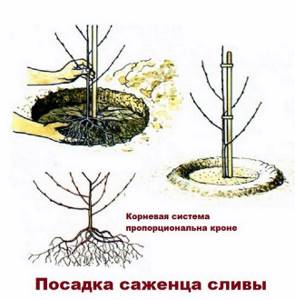
We recommend reading these articles:
Planting celery seedlings in 2021 according to the lunar calendar
Lunar sowing calendar for March 2021 for gardeners and gardeners
Good varieties of cucumbers for open ground are self-pollinating
Planting fruit bushes
The pits for berry bushes are prepared in advance, a month and a half in advance. Fruit and berry varieties prefer nutritious, humus-rich soil. Heavy soil needs to be improved before planting these plants. To do this, plant green manure (green manure) on it, and then mix the soil with sand and compost.
The dimensions of the pit are usually 40 cm wide and 30 cm deep. But if the seedling has a large ball of earth, then the size of the pit should be such that the roots fit freely into it.
A mound of topsoil is placed at the bottom of the pit, and a seedling is placed on it. If the roots are very long, they are not cut. In order for them to lie freely around the circumference of the hole, the seedling must be rotated several times. The bush is placed 5 centimeters deeper than it grew in the nursery. Thus, when deepening, additional roots are formed, the number of shoots increases and the survival rate of the plant improves.
When filling a hole, the top layer of soil is placed down and the bottom layer is placed on top. The soil is thoroughly compacted without damaging the roots. At the end, the planting site is watered abundantly (at least 10 liters of water). After 3-4 days, watering is repeated. Then the bush is moistened as needed.
When planting in autumn, it is better to plant a seedling of a fruit variety to a height of 20-30 centimeters, so that in the event of a snowless winter, the bush, weakened by transplantation, does not die.
Planting shrubs in spring
Shrubs, depending on the size of their growth, need different areas to provide them with food and light:
- for currants and gooseberries - at least 3 m2 (3x1 or 2x1.5);
- for raspberries - up to 1 m2 (2x0.5 or 1.5x0.5).
Currant and gooseberry seedlings are transplanted upon reaching 2 years of age, raspberries - one year old. When choosing a seedling, pay attention to the root system. A suitable option is thick roots with a sufficient number of regrown roots and a healthy cut.

Selection of seedlings
It is easier to choose the right type of seedlings in the fall, since the range of varieties offered is larger. It is better to purchase them from nurseries or gardening farms - this is a guarantee that they will not sell another plant instead of the one you need.
O fazende.ru recommends : How to care for fruit tree seedlings
What to look for when choosing:
- regionalization of the variety, i.e. adaptation to the local climate;
- availability of information about the characteristics and conditions of cultivation;
- age – 2-3 years, the best option is a two-year-old tree;
- height – 100-150 cm (if the seedling is higher or lower, the rules of care and fertilizing may have been violated);
- appearance – without damage, signs of disease, dark spots, mold. Straight and even trunk, the presence of at least three skeletal branches;
- branched root system - main and several lateral roots;
- the trunk of a seedling in a coma of earth should not dangle;
- the place of grafting is clearly visible - its presence guarantees that the tree is varietal;
- condition of the wood, bark - there should be no damage, frost holes, cracks, signs of sunburn;
- seedlings with open roots have unopened buds and no leaves; seedlings with closed roots may have leaves.
Related article:
Walnut at the dacha
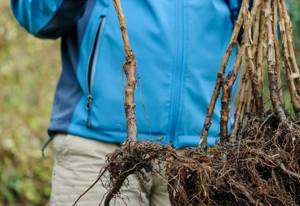
Coniferous species are purchased only with closed roots and planted in March-April.
How to care for fruit trees after spring planting?
It is important not only to know how to plant fruit tree seedlings in the spring, but also to provide proper care for young trees. They need to be given special attention in the first two years of life. It is necessary to take care of moderate regular watering and fertilizing, ensure loosening, and get rid of weeds. During the dry period, the soil around the planted trees must be thoroughly loosened periodically.
Don’t forget about mulching the tree trunks. The role of rotting mulch is difficult to overestimate:
- is a guarantor of excellent aeration of the rhizome;
- helps combat the problem of soil drying out;
- blocks weed germination;
- prevents soil freezing in the winter months;
- young plants receive the necessary organic nutritional components;
- reduces the risk of soil crust formation.
However, remember that soils that are overly moistened do not need to be mulched.

And most importantly, you need to remember: a tree is a living being and requires an appropriate attitude towards itself. Young seedlings, like small children, need constant attention and care; if they receive what they need, they will certainly please you with a good harvest.
